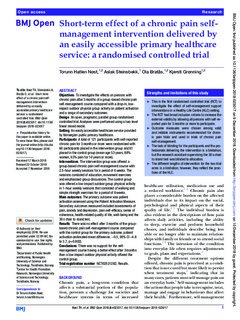| dc.contributor.author | Nøst, Torunn Hatlen | |
| dc.contributor.author | Steinsbekk, Aslak | |
| dc.contributor.author | Bratås, Ola | |
| dc.contributor.author | Grønning, Kjersti | |
| dc.date.accessioned | 2019-02-27T11:50:59Z | |
| dc.date.available | 2019-02-27T11:50:59Z | |
| dc.date.created | 2018-12-10T10:14:42Z | |
| dc.date.issued | 2018 | |
| dc.identifier.citation | BMJ Open. 2018, . | nb_NO |
| dc.identifier.issn | 2044-6055 | |
| dc.identifier.uri | http://hdl.handle.net/11250/2587781 | |
| dc.description.abstract | Abstract Objectives To investigate the effects on persons with chronic pain after 3 months of a group-based chronic pain self-management course compared with a drop-in, lowimpact outdoor physical group activity on patient activation and a range of secondary outcomes. Design An open, pragmatic, parallel group randomised controlled trial. Analyses were performed using a two-level linear mixed model. Setting An easily accessible healthcare service provided by Norwegian public primary healthcare. Participants A total of 121 participants with self-reported chronic pain for 3 months or more were randomised with 60 participants placed in the intervention group and 61 placed in the control group (mean age 53 years, 88% women, 63% pain for 10 years or more). Interventions The intervention group was offered a group-based chronic pain self-management course with 2.5-hour weekly sessions for a period of 6 weeks. The sessions consisted of education, movement exercises and emphasised group discussions. The control group was offered a low-impact outdoor group physical activity in 1-hour weekly sessions that consisted of walking and simple strength exercises for a period of 6 weeks. Main outcomes The primary outcome was patient activation assessed using the Patient Activation Measure. Secondary outcomes measured included assessments of pain, anxiety and depression, pain self-efficacy, sense of coherence, health-related quality of life, well-being and the 30 s chair to stand test. Results There was no effect after 3 months of the groupbased chronic pain self-management course compared with the control group for the primary outcome, patient activation (estimated mean difference: −0.5, 95% CI –4.8 to 3.7, p=0.802). Conclusions There was no support for the selfmanagement course having a better effect after 3 months than a low-impact outdoor physical activity offered the control group. Trial registration number NCT02531282; Results. | nb_NO |
| dc.language.iso | eng | nb_NO |
| dc.publisher | BMJ Publishing Group | nb_NO |
| dc.relation.uri | http://bmjopen.bmj.com/cgi/content/full/bmjopen-2018-023017 | |
| dc.rights | Navngivelse-Ikkekommersiell 4.0 Internasjonal | * |
| dc.rights.uri | http://creativecommons.org/licenses/by-nc/4.0/deed.no | * |
| dc.subject | Kronisk sykdom | nb_NO |
| dc.subject | Chronical disease | nb_NO |
| dc.subject | Pasientundervisning | nb_NO |
| dc.subject | Patient education | nb_NO |
| dc.title | Short-term effect of a chronic pain self-management intervention delivered by an easily accessible primary healthcare service: a randomised controlled trial | nb_NO |
| dc.type | Journal article | nb_NO |
| dc.type | Peer reviewed | nb_NO |
| dc.description.version | publishedVersion | nb_NO |
| dc.subject.nsi | VDP::Helsefag: 800 | nb_NO |
| dc.subject.nsi | VDP::Health sciences: 800 | nb_NO |
| dc.source.pagenumber | 12 | nb_NO |
| dc.source.journal | BMJ Open | nb_NO |
| dc.identifier.doi | 10.1136/bmjopen-2018-023017 | |
| dc.identifier.cristin | 1640934 | |
| dc.relation.project | Norges forskningsråd: 238331 | nb_NO |
| dc.description.localcode | This is an open access article distributed in accordance with the Creative Commons Attribution Non Commercial (CC BY-NC 4.0) license | nb_NO |
| cristin.unitcode | 194,65,20,0 | |
| cristin.unitname | Institutt for samfunnsmedisin og sykepleie | |
| cristin.ispublished | true | |
| cristin.fulltext | original | |
| cristin.qualitycode | 1 | |

